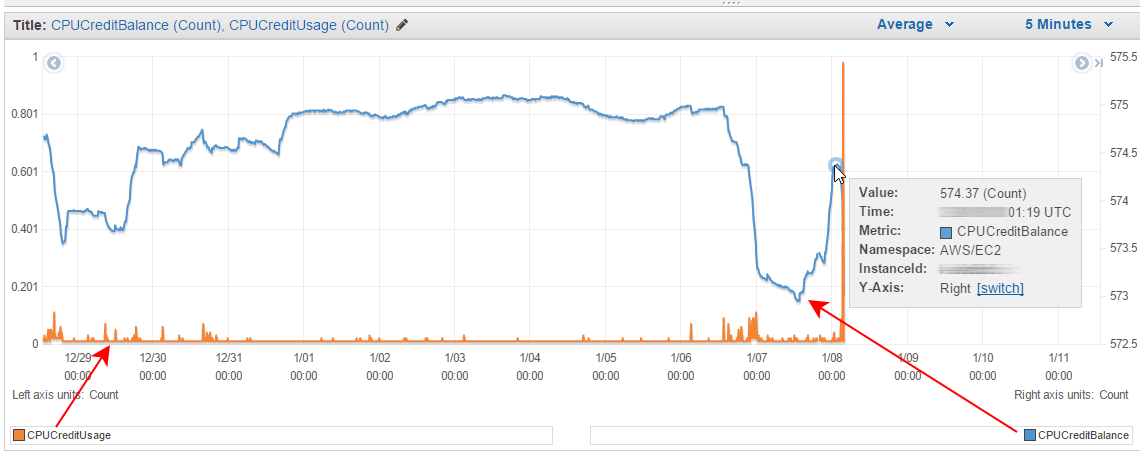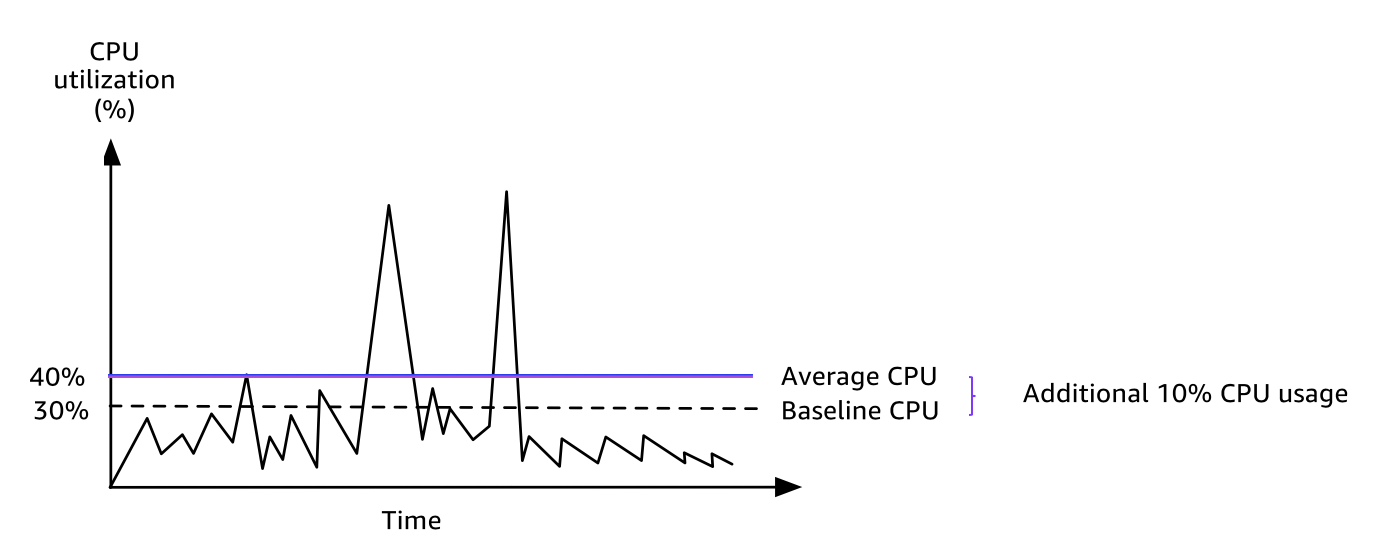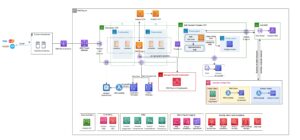CPU Credits per Hour is a metric used in Amazon Web Services (AWS) to measure the amount of CPU resources consumed by an instance within an hour. It determines the baseline performance of an instance and the number of CPU credits it earns or consumes during that time.
CPU credits are accrued when the instance’s actual CPU usage is below the baseline, and they can be used when the instance needs more CPU resources than its baseline. This allows for burstable performance in instances while optimizing costs. AWS uses CPU credits as a flexible and cost-effective way to manage CPU usage in instances.
Introduction To Cpu Credits On Aws
When it comes to cloud computing, AWS (Amazon Web Services) is one of the leading providers, offering a wide range of services and resources to support various workloads. One important aspect of AWS is the concept of CPU credits, which plays a crucial role in determining the performance and cost efficiency of your cloud-based applications.
The Concept Of Cpu Credits
In the AWS ecosystem, CPU credits are a unit of measure used to manage the performance of EC2 (Elastic Compute Cloud) instances. EC2 instances are virtual servers in the cloud that can be scaled up or down based on your application’s needs. CPU credits are essentially a currency that represents the amount of CPU resources available to an instance.
Each EC2 instance type is assigned a baseline performance level, which determines the number of CPU credits earned per hour. These credits can be used to burst above the baseline level when the instance requires more CPU power. The accumulation and usage of CPU credits are managed by the AWS infrastructure, allowing your applications to dynamically adjust their performance based on demand.
Relevance In Cloud Computing Performance
The concept of CPU credits is particularly relevant in cloud computing performance as it allows for efficient utilization of resources and cost optimization. By earning CPU credits during periods of low CPU usage, you accumulate a surplus that can be used during peak times when your application requires more processing power.
This burstable performance model ensures that your application remains responsive even during sudden spikes in demand. It also enables you to right-size your instances, choosing a smaller size with a lower baseline performance level and relying on accumulated CPU credits to handle occasional bursts of high CPU utilization.
Understanding CPU credits is crucial for optimizing the performance and cost-effectiveness of your AWS infrastructure. By effectively managing your CPU credits, you can ensure that your applications have the necessary resources to meet their performance requirements without overspending on unnecessary compute capacity.

Credit: dnx.solutions
How Cpu Credits Work
CPU credits on AWS determine the amount of CPU resources allocated per hour. The credits accrue when the CPU operates below baseline performance and are consumed when it exceeds it, ensuring fair resource distribution. This system optimizes performance and cost efficiency for varying workloads.
CPU Credits are a unique feature of Amazon Web Services (AWS) that allow users to burst their CPU usage when needed without incurring additional charges. Essentially, CPU Credits act as a currency for computing power, allowing users to utilize more processing power than their instance’s baseline performance would normally allow. Let’s dive into the basics of CPU Credit accumulation and utilization.Basics Of Cpu Credit Accumulation
AWS instances earn CPU Credits continuously over time, and the number of credits earned per hour varies depending on the instance type. CPU Credits are earned at a higher rate when the instance is idle or underutilized, and are used to make up for any shortfall in CPU performance during periods of high demand. CPU Credits are accumulated up to a maximum limit, which is also dependent on the instance type.Utilization Of Credits For Computing Power
When an instance requires more CPU power than its baseline performance can provide, it can utilize its accumulated CPU Credits to burst its CPU usage. This is particularly useful for applications with unpredictable or intermittent workloads that require occasional bursts of processing power. However, once an instance exhausts its accumulated CPU Credits, its CPU performance returns to its baseline level. To summarize, CPU Credits are a powerful tool for managing CPU usage in AWS instances. By understanding the basics of CPU Credit accumulation and utilization, users can optimize their instance’s performance and minimize their AWS costs.Aws Instances Eligible For Cpu Credits
When it comes to AWS instances eligible for CPU credits, understanding the allocation and utilization of CPU credits is crucial for optimizing performance and cost-effectiveness. AWS instances that are eligible for CPU credits are designed to offer burstable performance, allowing users to efficiently handle variable workloads while maintaining cost efficiency.
T2 And T3 Instances
T2 and T3 instances are popular options for users who require burstable performance. These instances are equipped with a baseline level of CPU performance, measured in vCPUs, which can be utilized continuously. When the workload demands exceed the baseline performance, these instances can tap into CPU credits to deliver additional processing power on a temporary basis.
Use Cases For Burstable Performance Instances
These burstable performance instances are well-suited for a variety of use cases, including development and testing environments, small to medium databases, web servers, and low-traffic websites. By leveraging CPU credits, users can efficiently manage intermittent spikes in their workloads without having to invest in constant high-performance resources.

Credit: www.cloudinsidr.com
Monitoring Cpu Credit Balance
If you are using Amazon Web Services (AWS) to host your applications, you may have come across the term CPU credits per hour. CPU credits are a way of measuring the amount of CPU resources that your instance is using over time. AWS provides CPU credits to instances that are running in burstable performance mode, which allows your instance to burst above its baseline performance when needed.
Tools For Monitoring
Monitoring your CPU credit balance is essential to ensure that your instance doesn’t run out of credits and experience performance issues. AWS provides several tools that you can use to monitor your CPU credit balance:
- CloudWatch Metrics
- CloudWatch Alarms
- EC2 Instance Connect
Interpreting The Cpu Credit Metrics
When monitoring your CPU credit balance, there are several metrics that you should pay attention to:
| Metric | Description |
|---|---|
| CPU Credit Usage | The number of CPU credits that your instance has used over the past hour. |
| CPU Credit Balance | The number of CPU credits that your instance has available. |
| CPU Credit Usage Percentage | The percentage of CPU credits that your instance has used over the past hour. |
By monitoring these metrics, you can ensure that your instance has enough CPU credits to handle the workload that it is currently running.
Cpu Credit Pricing
CPU Credit Pricing on AWS refers to the allocation of CPU credits per hour for burstable performance instances. This system allows users to accrue credits during low-usage periods and consume them during high-demand times, ensuring consistent performance without incurring additional costs.
Cost-effectiveness For Different Workloads
When it comes to CPU Credit Pricing on AWS, understanding the cost-effectiveness for different workloads is crucial. AWS offers a flexible pricing model that allows users to pay for the actual resources they consume. With CPU credits, you have the ability to burst your CPU usage when needed, making it cost-effective for workloads with varying levels of CPU utilization. For workloads that require consistent CPU performance, such as database servers or continuous data processing, it may be more cost-effective to use instances that provide a baseline level of CPU performance without relying heavily on CPU credits. These instances are designed to deliver consistent and predictable performance, making them suitable for applications that require sustained high CPU usage. On the other hand, for workloads that experience periodic spikes in CPU usage, such as web servers or batch processing jobs, instances with CPU credits can be a cost-effective choice. CPU credits allow you to accumulate credits when your workload operates below the baseline performance level, and then use these credits to burst above the baseline when needed. This burstable performance feature ensures that your workload can handle sudden increases in demand without incurring additional costs.Strategies To Optimize Cpu Credit Spending
To optimize your CPU credit spending on AWS, consider the following strategies: 1. Monitor CPU Credit Balance: Keep an eye on your CPU credit balance to ensure that it remains above zero during peak usage periods. If your CPU credit balance approaches zero, your instance’s CPU performance will be capped at the baseline level, potentially impacting your workload’s performance. 2. Right-Sizing Instances: Choose the right instance type for your workload to ensure that you have sufficient CPU credits to handle your workload’s demands. Consider the balance between baseline performance and burstable performance when selecting an instance type. 3. Utilize Auto Scaling: Implement auto scaling to dynamically adjust the number of instances based on workload demand. This allows you to effectively manage CPU credit spending by scaling up or down as needed, ensuring optimal performance and cost-efficiency. 4. Optimize Workload Design: Review your workload design to identify any potential optimizations that can reduce CPU usage. This can include optimizing code, leveraging caching mechanisms, or offloading CPU-intensive tasks to other services. By implementing these strategies, you can effectively manage your CPU credit spending on AWS, ensuring that you have the necessary resources to handle your workload’s demands while optimizing costs. Remember to regularly monitor and adjust your approach to align with your evolving workload requirements.Maximizing Cpu Credit Usage
Maximizing CPU credit usage is crucial for optimizing performance and cost efficiency in AWS. Understanding how to effectively manage CPU credits per hour can help you make the most of your resources and ensure optimal performance for your workloads.
Best Practices For Managing Workloads
When managing workloads in AWS, it’s essential to implement best practices for maximizing CPU credit usage. By utilizing the following strategies, you can optimize performance while efficiently utilizing your CPU credits:
- Monitor CPU credit balance regularly to prevent depletion.
- Implement auto-scaling based on CPU credit balance to maintain performance.
- Utilize burstable performance instances for workloads with fluctuating CPU demands.
Scaling Performance With Cpu Credits
Scaling performance with CPU credits in AWS involves leveraging the burstable performance capabilities of instances to accommodate varying workload demands. By effectively managing CPU credit usage, you can ensure that your applications and processes maintain optimal performance without incurring unnecessary costs.
Case Studies: Success With Cpu Credits
Discover the success stories of businesses leveraging CPU credits per hour on AWS. Learn how companies have optimized their resource allocation and costs through efficient management of CPU credits, resulting in improved performance and savings. Explore real-world examples of the benefits of utilizing CPU credits in AWS.
Small Business Use Case
Enterprise-level Application Examples
Case Studies: Success with CPU Credits Small businesses benefit from CPU credits by managing costs effectively. When resources are not consistently high, CPU credits optimize performance. In one case, a small e-commerce company utilized CPU credits to handle peak traffic. The flexibility of CPU credits ensured smooth operations without overspending. Enterprise-level applications, such as database management systems, also gain from CPU credits. Databases with varying workloads can use CPU credits to maintain performance. For instance, a large financial institution utilized CPU credits to scale during busy periods. This ensured stable performance without excess costs. In Summary: – Small businesses can maximize resources with CPU credits. – Enterprise-level applications maintain performance with CPU credits. – CPU credits enable scalability without overspending.Future Of Cpu Credits In Cloud Services
The future of CPU Credits in Cloud Services is an intriguing topic that holds great potential for shaping the way cloud computing services operate. As technology continues to advance rapidly, it is essential to explore how CPU Credits per hour on AWS and other cloud platforms are evolving to meet the increasing demands of users.
Evolving Cloud Performance Models
CPU Credits play a crucial role in determining the performance and efficiency of cloud instances. As cloud service providers strive to enhance their offerings, the evolution of cloud performance models is inevitable.
Predictions For Cpu Credit Enhancements
With the relentless pursuit of innovation in cloud technology, predictions for CPU credit enhancements are on the rise. These enhancements are expected to optimize resource allocation and improve overall performance.

Credit: docs.aws.amazon.com
Frequently Asked Questions
What Is Aws Cpu Credit Usage?
AWS CPU credit usage refers to the measurement of CPU utilization for Amazon EC2 instances. It determines the amount of CPU credits consumed by an instance during its operation. CPU credits are used to balance the performance of burstable instances.
When the CPU usage is below the baseline, credits are accumulated for future bursts. If the usage exceeds the baseline, credits are consumed. Proper monitoring of CPU credit usage helps optimize instance performance and manage costs efficiently.
What Happens When I Run Out Of Cpu Credits?
When you run out of CPU credits, your website or application will experience a performance slowdown or even become temporarily unavailable. This is because CPU credits are necessary for your website or application to operate at full speed. To avoid this, you may need to upgrade your AWS instance to get more CPU credits or optimize your application’s code to reduce CPU usage.
What Is Per Vcpu Hour?
Per vCPU hour refers to the pricing model for cloud computing, where the cost is based on the number of virtual CPUs used per hour. This allows for flexible and scalable pricing based on actual usage.
How Do I Check My Cpu Credits?
To check your CPU credits, go to the EC2 dashboard, click on the instance you want to check, and then look for the “CPU Credits” metric. You can also use the CloudWatch console to view the CPU credit balance and usage of your instance.
Conclusion
To sum up, understanding CPU credits per hour on AWS is crucial for optimizing costs. Monitoring and managing CPU usage efficiently can lead to significant savings. By leveraging this knowledge, businesses can ensure optimal performance and financial efficiency in their cloud operations.
Stay informed and make informed decisions.






